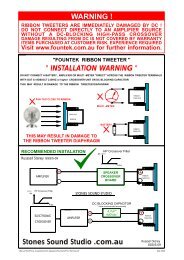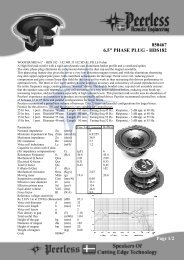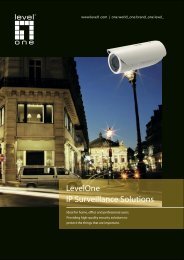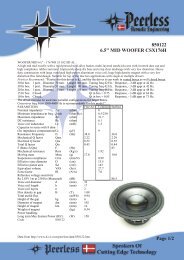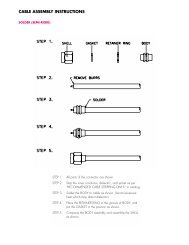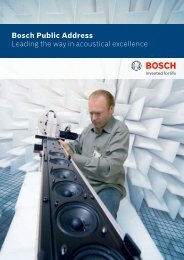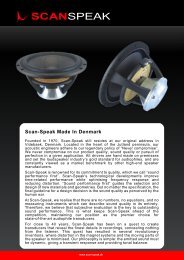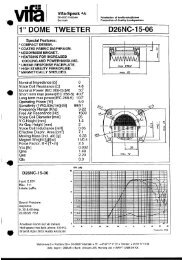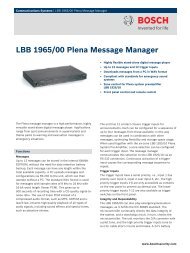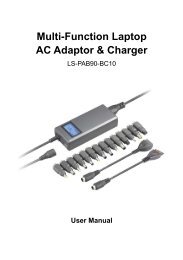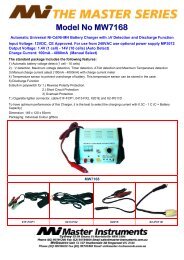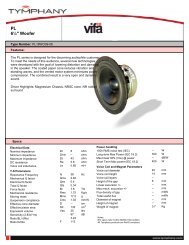Soldering station specifications - what do they mean - Tequipment.net
Soldering station specifications - what do they mean - Tequipment.net
Soldering station specifications - what do they mean - Tequipment.net
You also want an ePaper? Increase the reach of your titles
YUMPU automatically turns print PDFs into web optimized ePapers that Google loves.
SOLDERING STATION SPECIFICATIONS - WHAT DO THEY MEAN ?BACKGROUND.In response to several requests from customers facing ISO certification, curiosity-seekers, and the cat:There are oodles of standards describing <strong>what</strong> a soldering <strong>station</strong> should and should not <strong>do</strong>. Some of them are:DOD-STD-2000; MIL-STD-2000 (with half the alphabet chasing along after it); J-STD-001 and its offspring;occasionally one encounters a special project or company standard that obviously derives - perhaps at a greatdistance - from one of the more familiar standards. These standards exist because:a) The government, of which the military is a part, loves to control things. Imposing standards is one way to <strong>do</strong>that.b) Sometimes things actually need controlling. <strong>Soldering</strong> iron characteristics, for example, because volts ordegrees or ohms in the wrong place, or in the wrong proportions, can damage sensitive parts.DEFINITIONS.Temperature accuracy: You might say to yourself, 'Self, this is so obvious that even a geezer could understand it,given time.' In a way you would be right. Temperature accuracy is indeed how closely tip temperature comes to thetemperature you thought you set at the <strong>station</strong>. If you are of a curious turn of mind, or face a specification withpreposterous requirements, here is a brief explanation of the things that affect temperature accuracy, and how to getaround them.1. Things that affect temperature accuracy.a. The design of the control circuit. The designer would have loved to make the thing perfect, but therewasn't budget for that. He made some compromises. Perhaps the accuracy could have been + 0.001 o butit is more likely to be + 5 o . <strong>Soldering</strong> temperatures <strong>do</strong> not have to be held to the nearest femtodegree andthe sooner we all remember that the better off we'll be.b. Tolerances that exist in components.c. The tolerance that exists in the heater. Heaters aren't made with 10 -10 precision in their mix - if <strong>they</strong> were<strong>they</strong>'d cost more than your house - and each one is just the least little bit off-centre from perfect.d. The size and shape of the tip. The laws of thermodynamics and heat transfer work. Tips lose heat byradiation, convection, and conduction. The part that <strong>do</strong>es the work is conduction; the other two areparasites. If your tip is a big fat one, it will have a large mass-to-surface-area ratio and retain heat betterthan a long skinny one. If someone fans the tip with their hat, it will lose heat to the air moving by.2. How to get around them.a) Calibrate the <strong>station</strong> whenever tips or heaters are changed. Sometimes you can <strong>do</strong> this. Sometimes youcan't.b) Measure the temperature every now and again.Temperature stability: This is a measure of how well the control circuit works, allowing for this and that and thecircumstances that prevail. Stability is only valid when the iron is idling in its rest - it <strong>do</strong>es not have squat to <strong>do</strong> withthermal response when actually soldering.Thermal recovery. This is a measure of how well the control circuit works, too. When heat is lost from the tipthrough conduction, allowing a solder joint to be made, the tip's temperature will drop. I understand that. Youunderstand that. The cat understands that. 'Thermal recovery' <strong>mean</strong>s - how long <strong>do</strong>es it take THIS <strong>station</strong>, with THIStip at THIS temperature, to get back to temperature? The better the thermal recovery, the faster the operator canwork. Getting him/her/it to work faster is a personnel problem and not within the purview of this department.Tip-to-ground potential: Sometimes called ‘millivolt leakage’. The voltage existing between the soldering iron tipand the work<strong>station</strong> common point ground. It should not exceed 2mV per DOD-STD-2000; not specified in J-STD-001B.Tip-to-ground resistance: The resistance existing between the tip of the soldering iron and the work<strong>station</strong>common point ground. It should not exceed 5 Ω per J-STD-001B, appendix A, and 2 Ω per DOD-STD-2000.
Insulation resistance: The resistance between the soldering iron tip and its heating element (applies to Hakkosoldering irons, series 900, 903, 907, 908). Properly termed ‘isolation resistance', it is a measurement of the isolationof the tip from the transformer secondary winding.The temperature accuracy is + 15 o F. for any single measurement. This figure is obtained as follows:1. The accuracy of any soldering <strong>station</strong> is + 10 o F. from the displayed value (assuming that the <strong>station</strong> has adigital display).2. The temperature stability of a precision soldering <strong>station</strong> at idle (e. g. the Hakko 939) is + 1.8 o F. about theset temperature.3. The specified accuracy of the Hakko 191 or 192 thermometer circuit, with a fresh, clean K-thermocouplesensor, is + 10 o F. This is typical for any intrusive measurement.These values give an acceptable RSS temperature error of + 15 o F. FOR THE STATION ITSELF. The effect of thetip will be algebraically additive to this value.The following table sums up the progress, or lack of it, through the thicket of <strong>specifications</strong>.parameterMIL-STD- DOD-HDBK- WS-6536E MIL-S-45743E DOD-STD- J-STD-001B20002832000-1BTip temperature, degs Set + 10 o F. n/s Set + 10 o F. Set + 10 o F. Set + 11 o F. Set + 5 o C.Leak voltage, mV 2 RMS max



